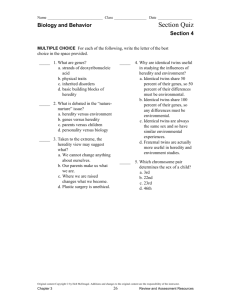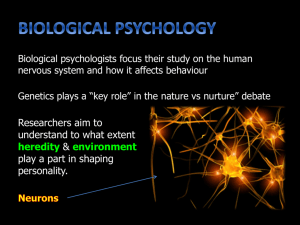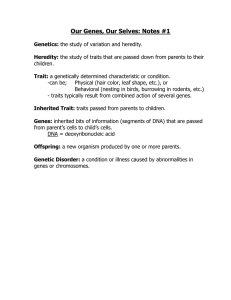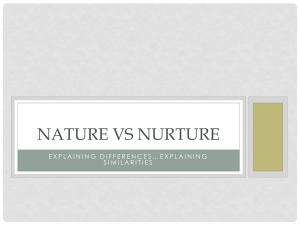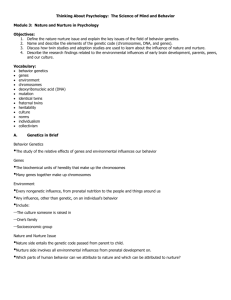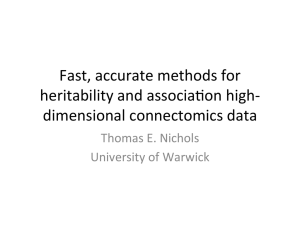Psychology 1230: Psychology of Adolescence
advertisement
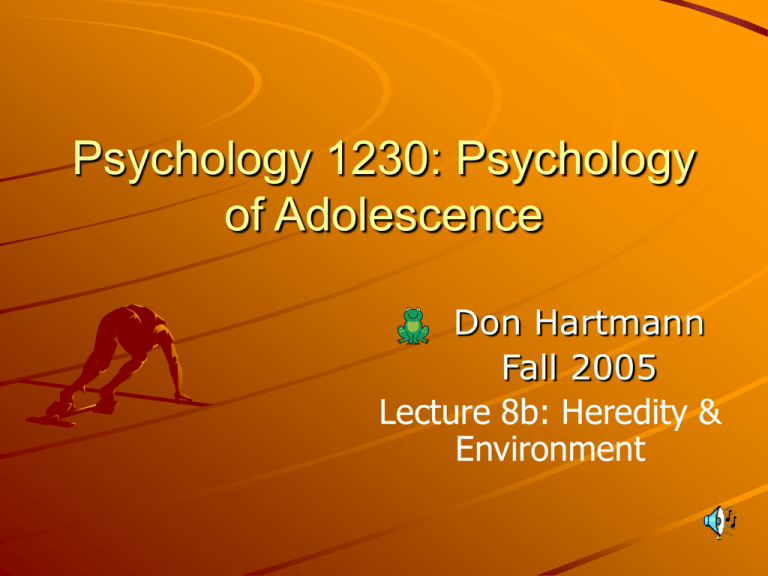
Psychology 1230: Psychology of Adolescence Don Hartmann Fall 2005 Lecture 8b: Heredity & Environment 1 Quiz 1 Information 80% of the multiple choice items will come from the study guides. The MC portion of the quiz will contain 30-40 items from the following sources: – 3-5 questions from each chapter, – 1-2 items from each lecture, and – 0-1 questions from each handout. The essay portion will include 3-5 relatively brief essay questions taken from the study guides. You will have some choice over which questions you can choose to answer 2 WEB Discussion Process Group Whippets Hotties 4♀+1♂ GypsyMafia JusticeLeague Psyched PithHelmets MAJACS #1 due 09/12 09/13 09/19 09/20 09/21 09/22 09/23 09/26 #2 due #3 due #4 due #5 due ---------Note: Anyone can contribute to any WEB discussion; group members are responsible to summarizing the discussion. The last day to contribute to any discussion is 3 days before the due date. 3 Handout Summary Handout Date 14. HO-Completing a Film Review* 15. HO-Preparing a Book Review 16. Completed Class Locator 08/31 17. Lect. #4: Introduction to Theory 18. Lect. #5: Bandura 19. Supplemental Lecture: Termpaper 20. Lect. #6: Method I 21. Lect. #7: Method II 22. Lect. #8: Puberty 23. Lect. #8b: Heredity & Envir. ----*Indicates handouts discussed in class. WEB Date 08/14 08/14 09/02 09/02 09/06 09/07 09/09 09/13 09/16 4 Supplementary References Plomin, R., DeFries, J. C., McClearn, G. E., & Rutter, M. (1997). Behavioral genetics (3rd ed.). New York: W. H. Freeman. Scar, S. (1993). Biological and cultural diversity: The legacy of Darwin for development. Child Development, 64, 859-865. 5 Overview Questions: – Why is it difficult to assess the contributions of heredity & environment on, say, the timing of puberty? – What is a heritability coefficient, and why should we care? – What are the contributions of shared & non-shared environments to our behavior? – What is a GEI, and why should we care? Intersects with the material in our text on pp. 109-112 and 152 Topics – Heritability Coefficients – Shared & Non-shared Environments – Genotypic-Environment Interactions Next: Lecture #9 (Piaget) 6 Heredity or Environment? 7 Comments on Behavioral Genetics Definition: Behavioral genetics—that field that seeks to discover the influence of heredity and environment on individual differences in human traits and development Important methods – Study of pedigrees: A simplified diagram of a family's genealogy that shows family members' relationships to each other and how a particular trait or disease has been inherited. 8 More on Methods: Adoption Studies – Adoption studies—e.g., the similarity of adopted children to their adopted parents and to their biological parents. If adopted children more closely resemble their biological parents than their adopted parents, we would conclude that the trait in question was at least partly hereditary determined (assuming the study was well done) If adopted children more closely resemble their adopted parents that their biological parents, we would conclude that the trait in question was at least partly environmentally determined (assuming…) For example, in one large study, the biological mother-adopted child correlation was 0.37 whereas the adoptive mother-adopted child correlations was 0.22. 9 More on Methods: Twin Studies – Comparisons of trait resemblence in identical & fraternal twins (kinship studies). For example, in studies involving more than 10,000 pairs of twins, the average “IQ” correlations are 0.85 for identical twins and 0.60 for same-sex fraternal twins. 10 The World’s First Genetically Engineered Human Hits Adolescence: ‘We buy you the best genes in the world — for this?’ (Thinks Dad.) 11 Summarizing Twin Studies Heritability Coefficients: Used to estimate the degree to which a characteristic is inherited, say IQ or shyness Compares the correlation between monosygotic twins (rMZ) and between dizygoticl twins (rDZ) If (rMZ) > (rDZ), heritability coefficient >0 12 More on the Hereditability Coefficient For example, if the rMZ = .85, and the rDZ = .60, H = 2(.85-.6) = 2(.25) = .50. And this value indicates at least a moderate tendency for the characteristic in question to be inherited For those other weirdos who like formulas, the formula for H is as follows (the rest of you close your eyes): H = 2[rMZ – rDZ] Interpretation requires some important assumptions. 13 Environments—Shared & Nonshared The contribution of non-shared environments: NSE = 1 - rMZ Some caveats regarding shared environments (Hoffman)—as they may have anomalous effects: – Can create differences as well as similarities (e.g., effect of divorce on different age children) – Non-identical twins may exaggerate differences The effects of shared environments, obviously, are strongest for dimension on which siblings are treated alike (e.g., religion) 14 Genetic Determinants of Behavior 15 Genotype/Environmental Interactions (GEIs): 1 Further messes our understanding of the contributions of nature and nurture to our behavior (phenotype) – In certain cases, genotypes and environments interact in atypical manners to produce phenotypes—e.g., your genotype might help determine the environment to which you are exposed! – As a result these GEIs make it difficult to distinguish genetic from environmental causes 16 Genotype/Environmental Interactions (GEIs): 2 Assume we wanted to apportion causes of a behavior to one of two categories: Genetic (G) and Environment (E). Where would we put the following example in which the focus is on a kids reading speed: Cause A (reading books) was E but was caused by the child’s G (the child’s hereditary predisposition to be smart). So do we put reading books in the G category or in the E category? G ? Reading ? Books E 17 Passive G/E Interactions Parents contribute to their children by providing them with genes and with an environment in which they can grow—and the environment which they provide is dependent on the parents' genes Consider EXERCISE. Parents who are genetically prone to exercise may provide an abundance of exercise equipment and encouragement. The equipment and encouragement are clearly Environment (E), but are they at some deeper level? Both may be functions of the parents’ Genes (G), right? 18 Evocative G/E Interactions Kids with different genes may evoke different reactions from their environment . E.g., smiley babies are responded to differently in their social environments than are smileless babies. So the responses of observers of the smiling child are environmental facilitators of the child’s increasing sociability. But the child “created” this environment by his/her genetic predisposition to be smiley. So are the adults who promote the child’s sociability G causes or E causes? 19 Active G/E interactions (Niche picking) The environments children choose will be dependent upon their genes—will be compatible with their genetic predispositions. E.g., smart kids chose to be in intellectually stimulating environments where they become even smarter, whereas not-so-smart kids chose less intellectually stimulating environments where their intellectual growth will be decelerated. So do these more and less intellectually stimulating environments belong in the G category or the E category? It is a puzzle, right? 20 Summary of Puberty Lecture Heritability coefficients Shared & Non-shared Environments Genotype- Environmental Interactions (GEIs) Next: Lect. #9 (Piaget) Go in Peace 21

